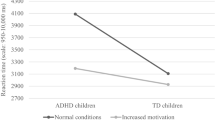Abstract
This study examined attentional and executive functions of 30 neglected children ages 8 to 12, who were compared with a control group of 30 children. Neuropsychological tests measured aspects of simple and complex attention. The results have shown that neglected children were not different from control children with simple tests of attention. However, neglected children were shown difficulties in executive functions, in particular in tasks requiring mental flexibility. Thus, results supported the presence of difficulties regarding executive functions in neglected children, and supported that this form of maltreatment had consequences on high-level mental functions.
Similar content being viewed by others
References
Achenbach, T. M. (2007). Assistant data manager. Toronto: Psychological Corporation.
Achenbach, T. M., & Rescorla, L. A. (1991). Manual for the Child Behavior Checklist. Burlington, VT: University Associates Psychiatry.
Achenbach, T. M., & Rescorla, L. A. (2006). The Achenbach System of Empirically Based Assessment. In R. P. Archer (Eds.), Forensic uses of clinical assessment instruments (pp. 229–262). Mahwah, NJ: Lawrence Erlbaum Associates Publishers.
American Psychiatric Association. (1994). Diagnostic and statistical manual of mental disorders (4th ed.). Washington, DC: Author.
Anderson, P. (2002). Assessment and development of executive function (EF) during childhood. Child Neuropsychology, 8(2), 71.
Anderson, V., Jacobs, R., & Anderson, P. J. (2008). Executive function and the frontal Lobes—A lifespan perspective. New York: Taylor & Francis Group.
Baddeley, A. (2002). Fractionating the central executive. In D. T. Stuss & R. T. Knight (Eds.), Principles of frontal lobe function (pp. 246–260). New York: Oxford University Press.
Barkley, R. A. (1997). Behavioral inhibition, sustained attention, and executive functions: Construction a unifying theory of ADHD. Psychological Bulletin, 12(1), 65–94.
Cicchetti, D. (2004). An odyssey of discovery: Lessons learned through three decades of research on child maltreatment. American Psychologist, 59, 731–741.
Cicchetti, D., & Toth, S. (1995). A developmental perspective on child abuse and neglect. Journal of the American Academy of Child and Adolescent Psychiatry, 34, 541–565.
De Bellis, M. D. (2005). The psychobiology of neglect. Child Maltreatment, 10(2), 150–172.
De Bellis, M. D., Hooper, S. R., Spratt, E. G., & Woolley, D. P. (2009). Neuropsychological findings in childhood neglect and their relationship to pediatric PTSD. Journal of the International Neuropsychology Society, 15, 868–878.
Delis, D. C., Kramer, J. H., Kaplan, E., & Holdnack, J. (2004). Reliability and validity of the Delis-Kaplan Executive Function System: An update. Journal of the International Neuropsychological Society, 10, 301–303.
Éthier, L. S., Lacharité, C., & Gagnier, J.-P. (1994). Prévenir la négligence parentale [Prevent parental neglect]. Revue québécoise de psychologie, 15(3), 67–86.
Gioia, G. A., Isquith, P. K., Guy, S. C., & Kenworthy, L. (2000). Behavior rating inventory of executive function. Child Neuropsychology, 6(3), 235–238.
Glaser, D. (2000). Child abuse and neglect and the brain—A review. Journal of Child Psychology and Psychiatry, 41(1), 97–116.
Kaufman, A. S., Kaufman, J. C., Balgopal, R., & McLean, J. E. (1996). Comparison of three WISC-III short forms: Weighing psychometric, clinical, and practical factors. Journal of Clinical Child Psychology, 25(1), 97–105.
Korkman, M., Kirk, U., & Kemp, S. (1998). A Developmental Neuropsychological Assessment (NEPSY). New York: Psychological Corporation.
Korkman, M., Kirk, U., & Kemp, S. (2003). NEPSY: Bilan neuropsychologique de la NESPY [A developmental neuropsychological assessment]. Paris: Editions du Centre de Psychologie Appliquée.
Laporte, P., Pépin, M., & Loranger, M. (2002). Le système attentionnel [The attentional system]. Québec: Le Réseau Psychotech Inc.
Leblanc, J., & Daigneault, G. (2003). Des idées plein la tête: Lancelot et les peuples du Savoir [Head full of ideas: Lancelot and peoples’ knowledge]. Montréal: Chenelière Education.
Lee, V., & Hoaken, P. N. S. (2007). Cognition, emotion, and neurobiological development: Mediating the relation between maltreatment and aggression. Child Maltreatment, 12(3), 281–298.
Nolin, P. & Ethier, L. (2007). Using neuropsychological profiles to classify neglected children with or without physical abuse. (2007). Child Abuse and Neglect, 31, 631–643.
Nolin, P., & Mathieu, F. (2001). L’importance de la sensibilité des mesures neuropsychologiques dans l’identification des déficits de l’attention chez les enfants ayant subi un traumatisme craniocérébral léger [The importance of the sensitivity of neuropsychological measures in identifying attention deficits in children with mild head trauma]. Revue de neuropsychologie, 11(1), 23–38.
Norman, W., & Shallice, T. (1986). Attention to action. In R. J. Davidson, G. E. Schwartz, & D. Shapiro (Eds.), Consciousness and self regulation: Advances in research and theory (pp. 1–18). New York: Plenum.
Pépin, M., & Loranger, M. (2007). Les logiciels RÉÉDUC [REEDUC software]. Québec: Le Réseau Psychotech Inc.
Schore, A. N. (2001). The effects of early relational trauma on right brain development, affect regulation, and infant mental health. Infant Mental Health Journal, 22(1–2), 201–269.
Shallice, T. (1995). Symptômes et modèles en neuropsychologie. Des schémas aux réseaux [From neuropsychology to mental structure]. Paris: Presses Universitaires de France.
Stuss, D. T., & Benson, D. F. (1984). Neuropsychological studies of frontal lobes. Psychological Bulletin, 95, 3–28.
Teicher, M. H., Ito, Y., Glod, C. A., Andersen, S. L., Dumont, N., & Ackerman, E. (1997). Preliminary evidence for abnormal cortical development in physically and sexually abused children using EEG coherence and MRI. Annals of the New York Academy of Sciences, 821, 160–175.
Trocmé, N., Fallon, B., McLaurin, B., Daciuk, J., Felstiner, C., Black, T., et al. (2003). Étude canadienne sur l’incidence des signalements de cas de violence et de négligence envers les enfants [Canadian incidence study of reported child abuse and neglect-2003]. Ottawa: Ministre de Travaux publics et Services gouvernementaux.
Wechsler, D. (1991). Manual for the Wechsler Intelligence Scale for Children (3rd ed.). San Antonio: The Psychological Corporation.
Author information
Authors and Affiliations
Corresponding author
Rights and permissions
About this article
Cite this article
Nadeau, ME., Nolin, P. Attentional and Executive Functions in Neglected Children. Journ Child Adol Trauma 6, 1–10 (2013). https://doi.org/10.1080/19361521.2013.733794
Received:
Revised:
Accepted:
Published:
Issue Date:
DOI: https://doi.org/10.1080/19361521.2013.733794




